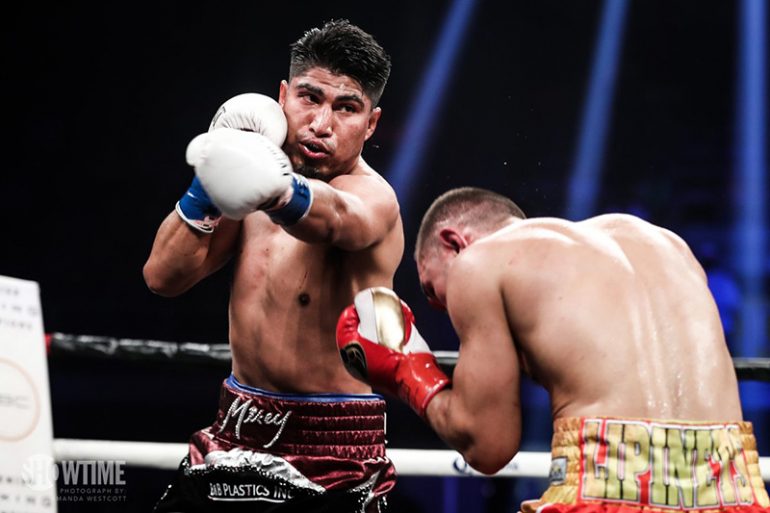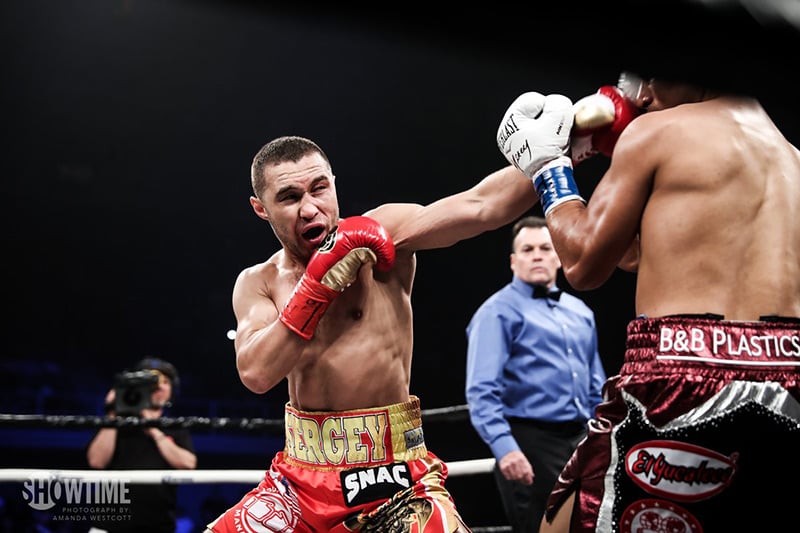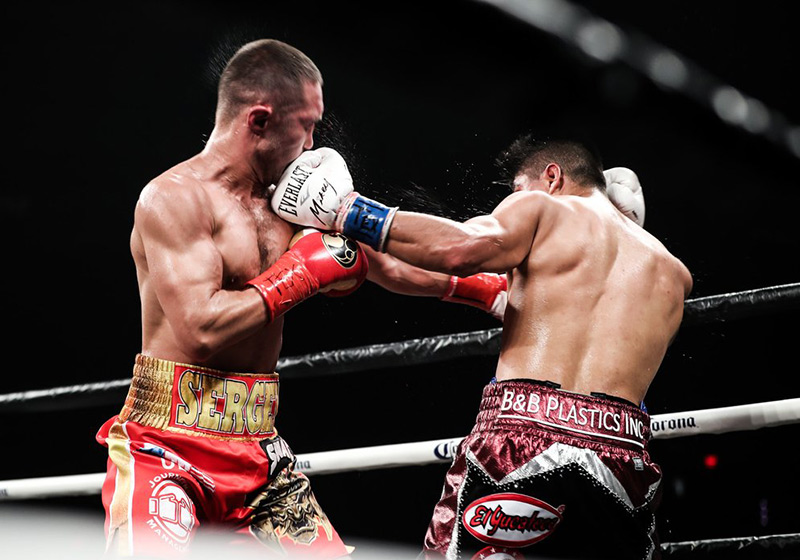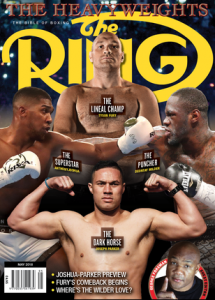The Travelin’ Man goes to San Antonio: Part three

Please click here to read Part One.
Please click here to read Part Two.
Saturday, March 10 (continued): When Mikey Garcia emerged from a momentum-killing two-and-a-half year hiatus precipitated by promotional disputes, one wondered whether he could pick up the pieces, much less regain his pound-for-pound status. After all, Garcia, who was on the other side of 28, at the start of his comeback, was nearing the end of his chronological prime and when he met Elio Rojas, he was, at 138, eight-and-three-quarters pounds heavier than he was when he out-pointed Juan Carlos Burgos in January 2014.
Twenty months and three fights after stopping Rojas in five rounds, Garcia, still the WBC lightweight king and now the new IBF junior welterweight titlist, thanks to his hard-fought unanimous decision victory over defending champion Sergey Lipinets, is back where he wants to be – on top, gaining momentum and, most importantly to him, overflowing with options.
“I can drop down to 135 pounds and unify, which I really want to do, then come back up and unify at 140 pounds,” Garcia said. After that, he said, watch out, welterweights.
Ambition is a wonderful asset but it’s even more so if you also own the physical tools and the political clout to turn ambition into reality. So far, Garcia is right on track and, better yet for him, he may have made up all the ground he lost during the break, in terms of titles won and standing in the sport. If one chooses to look at his situation from a glass-half-full perspective, Garcia saved himself two-and-a-half years of attrition and yet came away with his third and fourth divisional crowns. Those from a more negative viewpoint will say Garcia is nowhere near ready – and may never be ready – to take on WBA/WBC welterweight titlist Keith Thurman, Terence Crawford (who is expected to defeat WBO welterweight beltholder Jeff Horn next month) and IBF titleholder Errol Spence Jr. As is often the case, both sides make a valid point.

Photo / @ShowtimeBoxing
Based on his performance against Lipinets, Garcia would be wise to leave the welterweights alone. Against Lipinets, Garcia won more with intelligence and technique than his physical advantages, which were bigger factors at 126, 130 and 135. At 5-foot-7, Lipinets stood one inch taller and, in the ring, his physique looked strong, powerful and resilient. Also, he showed no effects from the hand injury that pushed this fight back a month. His jabs bloodied Garcia’s nose and his power shots penetrated with unsettling frequency and connected with noticeable impact. But because Garcia is an upper-crust talent with superb timing, he scored the fight’s only knockdown, in round seven, and came on stronger in the final two rounds, as he out-landed Lipinets 43-27 overall, 17-10 jabs and 26-17 power.
That surge enabled Garcia to seize final leads of 169-144 overall, 77-71 jabs and 92-73 power but while Garcia was the more accurate power hitter (46%-36%), Lipinets landed a higher percentage of his total punches (28%-25%) and, somewhat surprisingly, of his jabs (23%-16%).
One change in Garcia during his comeback is his ability to throw more punches in the early rounds. Earlier in his career, he was known as one of the sport’s most deliberate starters but in dethroning then-WBC lightweight titlist Dejan Zlaticanin, he out-threw the Montenegran 61-28 in round one, 67-22 in round two and 48-10 in the truncated third round. Against Adrien Broner, he slipped into his old ways by throwing just 13 punches in the first but “The Problem,” also a very slow starter, gave Garcia the room to gather himself by throwing just 26. In the second, Garcia upped his work rate to 44, while Broner appeared stuck in first gear for the remainder of the bout. By fight’s end, Garcia averaged 65.3 punches per round to Broner’s 33.3. Now against Lipinets, he led 39-18 in round one and out-threw the defending titlist in every round but the fourth, in which his edge was a mere 62-60.

Photo / @ShowtimeBoxing
More importantly, the round-by-round breakdowns had Garcia leading 8-4 in total connects, 6-4-2 in landed jabs and 9-3 in power connects, which was in line with the judges’ scorecards (117-110 twice, 116-111).
Lipinets, who came into the match as a 20-to-1 underdog, acquitted himself well, especially when one considers he was engaging in just his 14th professional fight and doing so against, by far, the best opponent of his career. Only an elite fighter would have beaten this version of Lipinets and, unfortunately for the defending titlist, Garcia, now 38-0 (30), is an elite fighter. However in this bout, Garcia didn’t radiate the same physical dominance in comparison to his opponent. Lipinets’ blows carried enough steam to register with Garcia, such steam to lead one to believe that welterweight, at least at this point, would be a step too far.
*
For many, including myself, Kiryl Relikh should already be 17 months into his 140-pound title reign but because the “Mad Bee” was stung by bad judging in back-to-back fights against Scottish WBA titlist Ricky Burns in Glasgow and Rances Barthelemy in their first fight in Oxon Hill, Maryland, last May, the Belarussian was forced to reset, revive and hope justice would finally prevail.
The total stats between fight one and fight two between Relikh and Barthelemy were remarkably similar. In fight one, Relikh out-landed Barthelemy 248 to 137 in total punches, while, in the rematch, Relikh landed 249 punches to Barthelemy’s 137. But because Relikh dramatically increased his average output from 80.8 punches per round to 103.1 and because Barthelemy’s work rate dropped from 43.4 to 41.2, the judges turned in scorecards that finally reflected reality. Alfredo Polanco and Cesar Ramos saw Relikh a 118-109 winner while Rafael Ramos scored the bout 117-110 for the new champion. Conversely, the panel of John Gradowski (116-110), Eugene Grant (115-111) and Don Risher (117-109) scored Barthelemy the victor in fight one, despite the fighters producing nearly the same number of connects. Talk about alternate universes.
The pivotal stretch occurred in rounds three through 11, all of which saw Relikh exceed 100 punches per round (he averaged 103.1 and topped off at 131 in the ninth), while Barthelemy, with the exception of round 10, when he threw 59, was mired in the 20s, 30s and 40s (he averaged 42 per round). Moreover Relikh out-landed Barthelemy 207-104 overall and 138-80 power in that span and, while Barthelemy was the more accurate hitter in all phases (28%-20% overall, 16%-14% jabs and 36%-26% power), the volume gap was simply too large for the Cuban to overcome.
Still, because of what happened last May – and because I’ve seen more than my share of lousy scoring in my 44 years as a boxing fan – I still held my breath, as I awaited the scorecards to be read. When they were, I, along with countless others, exhaled in relief.
*
While the last two days have been busy for me personally, the weekend was even more so at CompuBox in general, as counters also covered a pair of fight cards on ESPN – Golden Boy Promotions on Friday night and Top Rank on Saturday evening. Here are some of the numbers CompuBox President Bob Canobbio compiled in a piece titled “CompuBox: By the Numbers.”
* 8 – The average number of jabs per round landed by Ivan Baranchyk in his TKO win over Petr Petrov, which is double the total he averaged in his previous two fights.
* 12 – The number of punches landed per round by Sergey Lipinets, which is 30% higher than Mikey Garcia’s seven previous opponents.
* 57 – The number of punches landed by Brandon Figueroa in round three of his seventh round TKO win over Giovanni Delgado, more than triple the 122-pound average.
* 64 – The power punch percentage recorded by Regis Prograis in the second round of his TKO win over Julius Indongo, far above the 36% division average.
* 129 – The number of power punches landed by Scott Quigg on WBO featherweight titlist Oscar Valdez, the most by a Valdez opponent in 16 CompuBox-tracked fights.
* 176 – Punches thrown by Brandon Figueroa in round three of his victory over Delgado, nearly three times more than the 122-pound average.
* 485 – Number of power punches thrown by Valdez against Quigg, the most ever thrown by Valdez in 16 CompuBox-tracked fights.
What a weekend it was. But now that the fights have ended, it was time to prepare for the long journey home.
*
As I headed outside, I wondered how I would get back to the crew hotel, since the person who drove me to the venue – Sports Media’s Jeremy Thelen, would not be able to depart for a while yet. My first attempt to secure a ride was a failure: I was a moment away from climbing into a van with Farhood, Tompkins, Marquez and a few others but was told by Production Manager Angie Sztejn (who, among her other duties, coordinates the shuttles) that they were staying at a different hotel. She then suggested I ride with Associate Producer Mike Teodoru, who also was staying at that hotel but who, on his way there, would be driving by mine. That he did and, when he arrived, he dropped me off. Thanks, Mike – without you, it would have been a long and strange walk.
Although my work day was over at the arena, I still had tasks to perform before I could allow myself to turn out the lights in the room, as well as my own lights. First I needed to upload the data from the five matches Dennis Allen and I counted, a process that took nearly an hour to complete. Then I needed to unpack – I didn’t have time to do that when I first arrived in my room because my ride to the arena was waiting for me and our collective call time was at hand. After “settling in,” I took the elevator to the third floor, walked to the business center, checked into my flight and printed my boarding passes, another task I didn’t have time to complete upon arrival.
After all that, I was finally ready to go to sleep. Unfortunately for me, an extra premium on my rest time was imposed by the calendar as Sunday marked the start of Daylight Saving Time, which cut my slumber by an additional hour. I suppose I could have gotten upset about it but what good would it do? The situation would still be there and I’d then be sleepy and mad. So I chose to relax and make the best of things. At 2 a.m. – which instantly became 3 a.m. – I clicked off the lights and released my mind to the concept of full sleep for the first time in a long time.
Sunday, March 11: As expected, I slept very soundly for the next four-plus hours and I stirred from my rest/sleep 15 minutes before my goal time of 8 a.m. CDT. Although I felt a bit out of sorts, I knew a shower and a meal would restore me to a better state, which they did.
I checked out of my room at 9:30 a.m. And, when I mentioned my reason for being at the hotel, the woman at the registration desk brightened and said, “I don’t know much about boxing but, being from the Philippines, I know Manny Pacquiao.” That, more than anything, illustrates the reach of the “Pac-Man,” especially in his home nation. Only the greats have that kind of impact among those whom otherwise know nothing, nor care to know, about boxing. In this respect, Muhammad Ali truly was the greatest because his reach extended into the political and spiritual and transcended race and socioeconomic circumstance. Mention the name “Muhammad Ali” to almost anyone and one can see the instant recognition. The eyes light up and the faces almost always break into a smile. With his passing in 2016, the world lost one of the last remaining universal superstars. But I digress.
As is often the case with me, the taxi ride to the airport was a lively one because I often chat with the driver. Our conversation centered on Cuba, the nation of the driver’s birth. He was one of the lucky ones, in that most of his family now lives in the U.S. Only one son remains there and he is hopeful that he will get into the U.S. within two or three years. Two of his other children, ages nine and one, have lived in America their entire lives and the older one is fluently bilingual. By the time we arrived at the airport, we had created a friendly bond, which is a nice way to start the day.
As for breakfast – a rarity for me, given my sleep schedule and that I usually don’t get hungry until noon – I stopped by a Philly-style outlet and ordered a sausage, egg and cheese sandwich. While this isn’t the healthiest choice, it really hit the spot because it was my first real meal, since the crew dinner almost 18 hours earlier.
It’s strange; although I go long periods without eating on many trips, I don’t feel any ill effects, for the most part. That’s because, even after all these years, they provide a sense of adventure that, in turn, injects me with enough adrenaline to see me through. There may come a time when I might become jaded about it all but I don’t think it’s likely because, at 53, I’m pretty certain my general nature isn’t going to change much for the rest of my life.
Today’s itinerary is straightforward: An American Airlines flight from San Antonio to Dallas Fort-Worth, set to leave at 12:30 p.m., then, after a 55-minute connection window, a plane from DFW to Pittsburgh that is scheduled to touch down at 6:08 p.m. If all goes well, I’ll arrive home between 8:45 and 9 p.m.
I spent most of the flight to DFW resting my eyes further but I spent a sizable portion of the flight back to Pittsburgh talking to Joey and Lauren, a young couple who was on the final leg of a long and somewhat troubled return trip from Melbourne, Australia. While they had a marvelous time visiting family and taking in the sights, they came very close to missing this connection, so close that they had to sprint to the gate just minutes after finishing a 17-hour flight from Melbourne to Dallas. While I sat on the aisle of row 16, Lauren sat in the middle seat while Joey occupied the seat next to the window. Knowing what it’s like to be stuck in the middle seat with a long trip ahead, I immediately offered Lauren the armrest, a gesture she appreciated.
Despite their troubles, I still envied the fact they still got to go to Australia, which remains a dream destination for me. A little-known fact: I was booked to work a one-night, eight-man heavyweight tournament, which was to be staged in Melbourne in 2005. The itinerary was in place; the plane tickets were issued. My work visa was in order and my vacation time from The Parkersburg News was reserved. However it wasn’t to be; several fighters pulled out and were replaced by several others but, when the attrition got to the breaking point, the event was canceled just three days before I was to leave.
In retrospect, it would have been a daunting challenge for me, as it represented only the third set of flights I had ever taken and the first that involved changing planes. I don’t have an official “bucket list” but if I had one, a trip to Australia would be at the top.
Because we had flown from west to east, we landed in Pittsburgh well before schedule and, in turn, I arrived home around 8:30. While I love to travel, it was great to be home again.
I’m also happy that I will be home for nearly three weeks because the back-to-back trips caused me to fall behind on several ongoing projects, one of which will be the release of “Muhammad Ali: By the Numbers,” co-written by Canobbio and me. As of this writing, we are in the final stages of production and, as soon as the “all clear” is sounded, it will be released to the world. I can hardly wait.
My next journey is set to begin April 6, when I will travel to Las Vegas to count, along with Dennis Allen, a Showtime card featuring the rematch between IBF super middleweight titlist Caleb Truax and James DeGale, the man from whom Truax won the title, and a 154-pound title unification contest between WBA titlist Erislandy Lara and his IBF counterpart Jarrett Hurd. A bonus: The card will be staged at the Hard Rock Hotel and Casino.
Until then, happy trails!
*
Lee Groves is a boxing writer and historian based in Friendly, West Virginia. He is a full member of the BWAA, from which he has won 15 writing awards, including 12 in the last seven years and two first-place awards since 2011. He has been an elector for the International Boxing Hall of Fame since 2001 and is also a writer, researcher and punch-counter for CompuBox, Inc. He is the author of “Tales from the Vault: A Celebration of 100 Boxing Closet Classics (available on Amazon)” and the co-author of the upcoming book “Muhammad Ali: By the Numbers.” To contact Groves, use the email [email protected]
Struggling to locate a copy of THE RING Magazine? Try here or
Subscribe
You can order the current issue, which is on newsstands, or back issues from our subscribe page.
















